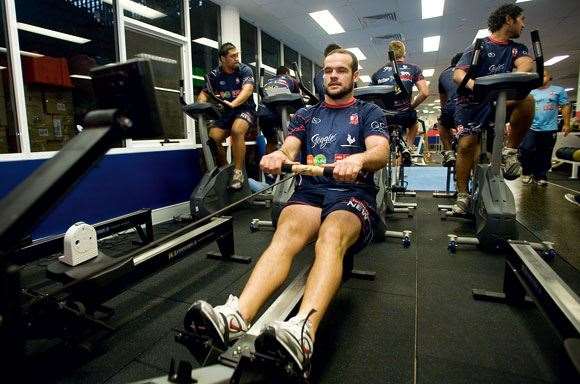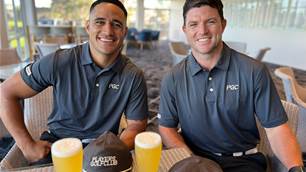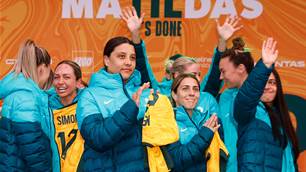For the most up-to-date slant on the physical attributes required of leaguies, you’re best to speak to Sydney Roosters workhorse Nate Myles.
For the most up-to-date slant on the physical attributes required of leaguies, you’re best to speak to Sydney Roosters workhorse Nate Myles.
 “I made sure I kept turning the legs over at Christmas so that when I came back I felt a lot better for it.” Images: Warren Clarke
“I made sure I kept turning the legs over at Christmas so that when I came back I felt a lot better for it.” Images: Warren ClarkeFor a revealing insight into the evolution of Homo Sapiens over the last 50,000-100,000 years, fly to New York and check out the American Museum of Natural History’s Human Origins exhibition. For a more modern summary, of not so much human evolution, but of changing body shapes in sport, cast your eye over any rugby league match footage pre-dating 1960 (those “big” blokes, the size of today’s three-quarters, they’re the props). But for the most up-to-date slant on the physical attributes required of leaguies, you’re best to speak to Sydney Roosters workhorse Nate Myles.Myles, picked again this year to partner the likes of Petero Civoniceva and Dave Taylor in the Queensland Maroons’ thunderous engine room, is living proof that today’s on-demand society and possibilities haven’t been lost on NRL coaches. Upon his arrival at the disgrace-stricken, wooden spoon-winning Bondi club, new chooks clipboard-holder Brian Smith saw what everyone else did in Myles, a damaging prop. But he needed something else – speed, an extra attacking option – and went about transforming the Cairns product to fit in with whatever schemes were on his drawing board. Gone are the days of coaches and recruiters’ options being limited to raiding the prop shop for established big men, or the wing ranks for a player with pace – modern NRL stars must be turned into whatever they need to be.
Myles’ reconfiguration between the final game of the 2009 season and the opening match of this year’s campaign may have cost him 10kg, but he’s lost nothing in terms of impact and contribution to the Roosters’ cause. Used predominately as a lock forward/second-rower, a leaner, speedier Myles upped his work rate to sit in the NRL’s top five of tackles made and top 20 in metres gained during the opening-to-middle stages of the 2010 season.Well-publicised alcohol-fuelled episodes which don’t need to be expanded upon here cost him six games through suspension in 2009, but the Roosters’ new man’s only worries in 2010 appear to be contending with coach Smith’s increased demands, and hurtling his club towards the opposition line and towards a return to semi-final football. His five 70-minutes-and-over efforts during rounds 1-10 of this year’s NRL caught the eye of Australia’s selectors, who made him the ‘Roos’ 18th man for the recent Trans Tasman Test in Melbourne. Myles, well and truly on a mission to prove he’s on the road to redemption in 2010, was kind enough to share a few of his off-season weight-loss secrets with Inside Sport.
BIG CHANGES
“Over the off-season the club went through a big transformation – the whole coaching staff, a few new players in key positions, etc. After the 2009 season all the players had individual meetings with the new head coach, Brian Smith. He let me know he had a positional change in mind for me in 2010. He wasn’t going to play me in the front row any more – I’d be playing more in the back row/lock area, which means a different role on the field. I knew I’d be playing a lot more minutes per game this year.
“I probably would’ve been able to play in the back row at my old body weight, but it’s a bit safer for the team for me to play a bit lighter so I can last a lot longer each game.
“It was actually a mutual decision between the coaching staff and me for me to play lighter. I had to plan it out and work out what weight I wanted to get to. It’s been a different training regime for me in that I’ve been speed-coached as well.”
Related Articles

Viva Las Vegas: Join Golf Australia magazine's Matt Cleary on a golf and rugby league spectacular

19 Holes With ... Chad Townsend and Val Holmes













